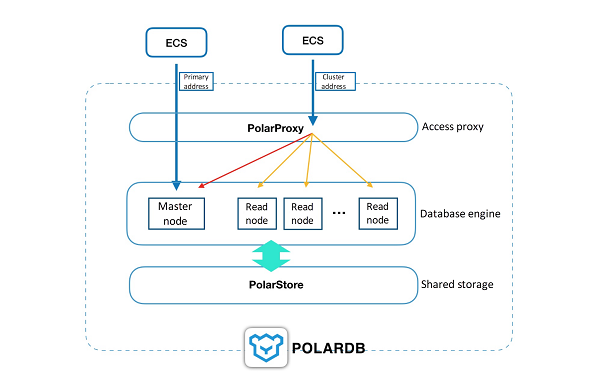By Yixiu
PolarDB is the next-generation relational distributed database developed by Alibaba Cloud, which is 100% compatible with MySQL. Applications using MySQL could use PolarDB without modifying a line of code.
PolarDB runs in the form of a multi-node cluster, which includes a Writer node (master node) and multiple Reader nodes. The nodes share the same storage (PolarStore) at the bottom tier through a distributed file system (PolarFileSystem).
PolarDB provides services externally through an internal proxy tier, meaning that all applications go through this tier before accessing specific database nodes. Proxy does not only perform authentication and protection, but can also parse SQL, send write operations (such as transactions, Update, Insert, Delete, and DDL) to the Writer node, and distribute read operations (such as Select) to multiple Reader nodes in a balanced manner, which is also called Read/Write Splitting.
PolarDB provides two database addresses by default, one is cluster address and the other is primary address. It is recommended to use cluster address because it provides Read/Write Splitting function that integrates the resources of all nodes to provide services externally. The primary address is always pointed to the master node. SQL accessing the primary address is sent to the master node. When a master-slave switch (Failover) occurs, the primary address is automatically shifted to the new master node within 30 seconds to ensure that the application is always connected to the writable and readable master node.

As shown in the diagram above, the bottom tier is a storage tier to save costs, which is "integration"; The middle tier has multiple nodes to improve scalability, which is "splitting"; The upper tier is a proxy tier, which provides a unified portal for easy use, which is also "integration". The "integration-splitting-integration" architecture maintains a balance between scalability and ease of use, making it as simple as using a single-point MySQL database for upper-tier applications.
PolarDB is deployed in the cloud. When you create it, you need to choose the geographical availability zone and the specific VPC network to be used first, and then specify the number (from 2 to 16) of nodes and their configuration (from 2 cores to 88 cores). You do not have to configure storage space in advance, nor do you need to pay attention to the capacity size.The system automatically charges according to actual usage.
The creation process may last for 5-10 minutes, and then you can configure the whitelist and create a high-privilege account. And that's it. You can create a logical DB and account User in the console, or you can log on to the database through a high-privilege account to execute SQL to create them.The results of the two methods are exactly the same.
DTS is recommended if you need to migrate the old database to PolarDB. Regardless of whether the source library is in MySQL built by RDS or ECS, or even in MySQL with public network address accessible under the cloud, online smooth migration can be done through DTS with downtime of 5-10 minutes.
In addition to using PolarDB like MySQL, it also has a few advantages that traditional MySQL databases do not have.
JDP - August 12, 2021
Alibaba Cloud Community - January 6, 2023
ApsaraDB - February 21, 2023
ApsaraDB - April 1, 2019
digoal - October 16, 2023
Alibaba Clouder - April 9, 2018
 ApsaraDB RDS for MySQL
ApsaraDB RDS for MySQL
An on-demand database hosting service for MySQL with automated monitoring, backup and disaster recovery capabilities
Learn More PolarDB for MySQL
PolarDB for MySQL
Alibaba Cloud PolarDB for MySQL is a cloud-native relational database service 100% compatible with MySQL.
Learn More PolarDB for PostgreSQL
PolarDB for PostgreSQL
Alibaba Cloud PolarDB for PostgreSQL is an in-house relational database service 100% compatible with PostgreSQL and highly compatible with the Oracle syntax.
Learn More PolarDB for Xscale
PolarDB for Xscale
Alibaba Cloud PolarDB for Xscale (PolarDB-X) is a cloud-native high-performance distributed database service independently developed by Alibaba Cloud.
Learn MoreMore Posts by ApsaraDB